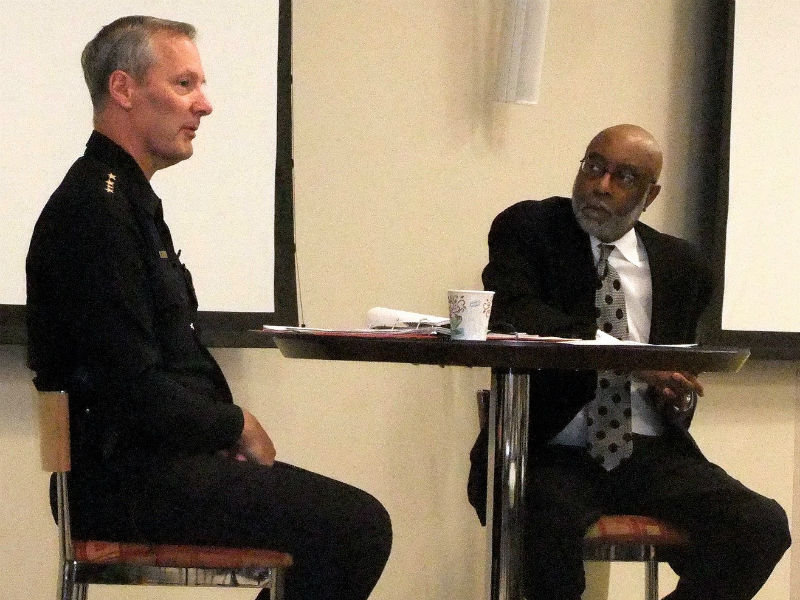The opinions expressed in this piece do not necessarily reflect the opinions of OnMilwaukee.com, its advertisers or editorial staff.
This is a challenge to the media, especially TV. Please stop bombarding the community with dehumanizing, crime scene frame coverage of shooting after shooting without contextualizing the crime debate for the public. Please stop reporting the crime debate in episodic, fragmented fashion.
Case in point: the recent individual stories on defendants, such as an accused carjacker, getting low bail amounts for serious crimes in Milwaukee; one then allegedly reoffended. What the media isn’t telling you when they report these individualized cases? The few cases they’ve highlighted are not aberrations. Bail amounts of $10,000 or less are the norm in Milwaukee County courts when it comes to at least one category of the most serious offenders: those charged with illegal gun offenses.
What happens then is that some of these accused gun offenders commit new crimes – including very serious ones – violate pretrial supervision by failing drug tests and/or intimidate witnesses or victims so cases fall apart. It strikes me that most people probably thought that people who are charged with shooting people in Milwaukee, or illegally carrying weapons as felons, are immediately incarcerated and stay there until sentencing, off the streets. However, this is routinely not the case.
How do I know this? Because three of my student journalists at the University of Wisconsin-Milwaukee – Pakou Lee, Rebecca Papenthien and Emily Zantow – spent a semester studying Milwaukee County’s gun court, the court where non-fatal shootings are sent (the sample also included many weapons possession cases, such as felon in possession of a firearm). Altogether, they reviewed 550 cases that had in-court activity in gun court from August to May.
Yes, 550.
This kind of reporting takes work and dedication. In an era of declining media resources, there aren’t many people taking the time to inform the debate this way (although there are a few). I wish the media would spend more of its resources informing us with such data points and spend less time on warring rhetoric we’ve all heard way too many times or the same video of a crime scene that looks indistinguishable from the next.
Why does this matter? Data points help the system pinpoint possible solutions. If serious gun offenders didn’t bail out for months at a time because their cases are pending in an overcrowded court system, they wouldn’t be on the streets to reoffend and intimidate victims and witnesses, a rising issue in Milwaukee County. Would you testify against a gun offender if he was back out on the streets in your own neighborhood awaiting trial?
How to speed up cases? That might require a second gun court; that’s a resource issue, and the court system is funded by the state. Yet, the rhetoric tends to always focus on adding more cops. That’s how data points can inform the debate or at least infuse it with new ideas.
There is a lot of academic research that shows the media’s heavy diet of episodic crime scene scare coverage distorts citizens’ perspectives about the amount of crime in their communities. Print media have historically been the best at connecting-the-dots coverage, but other than some good work on federal court, I haven’t seen a lot of context recently in the crime debate in Milwaukee.
I tell students to look for the patterns, in part, when dealing with a data set so large. I also instructed them to conduct human interviews to contextualize the data. The student findings give us a window into how firearm-related crime is handled in Milwaukee. It is another facet in a complicated debate.
So what really happens in gun court? The results were fascinating.
-
The student analysis showed that $10,000 bail is actually high for many serious crimes in Milwaukee. In gun court, the median bail was $5,000 ($10,000 for cases where people endangered safety and $3,000 for felons possessing firearms who weren’t also charged with other offenses). Median is the best way to assess the "typical" because the average is skewed upward by a few unusually high cases, although average wasn’t that much higher, either.
-
This matters because when people bail out and their cases drag for months in an overcrowded criminal justice system, they stay on the streets to reoffend or intimidate witnesses and victims. There is a serious, growing witness and victim intimidation problem in Milwaukee, the students found. Wisconsin has a speedy trial rule. When this isn’t met because the court system is too crowded, people get released pending trial or some other resolution of their case.
-
The students found a pattern in which gun court defendants had already been charged with new crimes – in some cases for very serious offenses, including new firearms charges and, in two cases, homicide. Indeed, one of these defendants was the accused killer of Laylah Petersen, the little girl shot inside her own home while sitting on her grandfather’s lap. He was in gun court for another shooting, given $10,000 bail and violated pretrial supervision with little consequence. In about 90 cases, defendants were charged with new crimes after the date of the gun court filing (and many had little time to mess up because some of the cases in gun court were filed in 2016).
-
There is a very strong nexus between gun offenses and the city’s drug trade. Many of the defendants had past drug records or were also charged with drug offenses.
-
In about one-fifth of the cases, all charges were dismissed, not counting those sent to federal court. The reasons included mess-ups by the system that ranged from DNA testing issues to discovery problems. However, they also included numerous cases tossed for lack of victim or witness cooperation.
-
Remember how upset people were about pretrial supervision of juvenile car thieves? It turns out that adult gun offenders don’t always do well on county pretrial supervision, either. The students found a pattern in which gun offenders had violated pretrial supervision, sometimes repeatedly, but the system does nothing in response (or just ups their bail slightly). They violate supervision by failing drug tests, violating GPS rules and blowing off contacts. The records are replete with the judges just admonishing gun defendants when this occurs, and they remain out on bail.
-
The average and median sentences were less than just over two years of confinement time (jail or prison, not counting stayed terms and counting all charges in a case). Forty percent of the defendants did not get prison time that wasn’t stayed (meaning they received jail, probation or fines). Even some felons in possession of firearms received probation.
-
There was an enormous racial and gender disparity. More than 90 percent of gun court defendants were black and male. Almost all had home addresses on Milwaukee’s North Side.
-
Five of the gun court defendants were previously convicted of homicide.
-
The Legislature did pass mandatory minimums for some gun offenders, but the study found many wouldn’t fall under them anyway, partly because a portion were not felons.
-
The students also studied a sample of gun cases in Waukesha County. They found far fewer cases, but that it was more common for Waukesha County gun defendants to receive fines, probation or just short stints in jail. Sometimes prison was not available to judges because the cases were misdemeanors. Waukesha County gun defendants had less serious records as a whole, though, and fewer cases were dismissed overall.
-
Some gun offenders flashed wads of cash or even guns in social media bragging.
An example of a case in the student study: "One Milwaukee man, charged with being a felon in possession of a firearm, violated pretrial supervision at least eight times after being released on $2,500 bail. ‘Court takes no action,’ the records repeatedly say.

"The month before the felony charge, the man was accused of misdemeanor disorderly conduct, but the case was tossed out when the prosecution declared it could not proceed. Why was he a felon? In 2011, he was convicted of possessing a short-barreled shotgun/rifle and given 120 days in the House of Correction.
"In the felon in possession of a firearm case? The judge sentenced him to 90 days in work-release jail and probation (with a stayed sentence he doesn’t have to serve unless he messes up again). A Facebook photo of the man is below (with his face cropped out)."

You can read the full student report on our student news site. If you care about the issue of crime in Milwaukee, it’s worth the read.
Jessica McBride spent a decade as an investigative, crime, and general assignment reporter for the Milwaukee Journal Sentinel and is a former City Hall reporter/current columnist for the Waukesha Freeman.
She is the recipient of national and state journalism awards in topics that include short feature writing, investigative journalism, spot news reporting, magazine writing, blogging, web journalism, column writing, and background/interpretive reporting. McBride, a senior journalism lecturer at the University of Wisconsin-Milwaukee, has taught journalism courses since 2000.
Her journalistic and opinion work has also appeared in broadcast, newspaper, magazine, and online formats, including Patch.com, Milwaukee Magazine, Wisconsin Public Radio, El Conquistador Latino newspaper, Investigation Discovery Channel, History Channel, WMCS 1290 AM, WTMJ 620 AM, and Wispolitics.com. She is the recipient of the 2008 UWM Alumni Foundation teaching excellence award for academic staff for her work in media diversity and innovative media formats and is the co-founder of Media Milwaukee.com, the UWM journalism department's award-winning online news site. McBride comes from a long-time Milwaukee journalism family. Her grandparents, Raymond and Marian McBride, were reporters for the Milwaukee Journal and Milwaukee Sentinel.
Her opinions reflect her own not the institution where she works.







